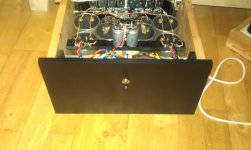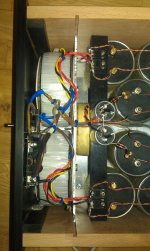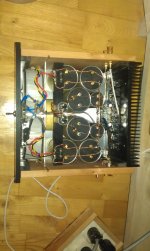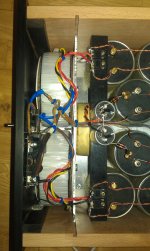Great, that sounds really interesting!
So my nxV200 sig´s then only miss out on the optional dedicated VAS supply...
Would sure love to have that
-Would it make sense to have the VAS supply externally regulated for extra stiffness and noise rejection?
Cheers,
Yes a regulated low noise supply would be the best option to get the best out of using separate VAS power supply.
Cheers
Anthony
With the R2s you can expect sharper focus on the imaging and sound stage.
The nxV200 Signature already has the nested feedback.
For the VAS supplies it is best to have at least 5 volts higher that the main output stage.
Cheers
Anthony
Anthony,
Would you say that the R2´s surpass or are equal in imaging focus sharpness and sound stage to the less powerful nxV200 Signature?
I´d guess that the better utilization potential of the VAS on the R2´s is (or can be) a game changer (if a high quality independently regulated VAS supply is employed)...
Cheers,
Hi Juhleren
The R2 nxv300 and nxV500 are based on the nxV800 module
Cheers
Anthony
Hi Anthony
If R2 versions are based on the nxV800, why they have different distortion characteristics?
Thanks!
Yes a regulated low noise supply would be the best option to get the best out of using separate VAS power supply.
Cheers
Anthony
Hi Anthony
How much current the regulated supply should be able to deliver to be enoungh for VAS supplying?
Thanks!
Hi Anthony
How much current the regulated supply should be able to deliver to be enoungh for VAS supplying?
Thanks!
A 200ma Supply would be more than enough to drive the VAS-Driver stage per supply rail.
Cheers
Anthony
Anthony,
Would you say that the R2´s surpass or are equal in imaging focus sharpness and sound stage to the less powerful nxV200 Signature?
I´d guess that the better utilization potential of the VAS on the R2´s is (or can be) a game changer (if a high quality independently regulated VAS supply is employed)...
Cheers,
?
Hi Juhleren
Sorry for the late reply
I have been away over the weekend.
Yes the R2 modules would be equal in sharpness, focus and sound stage
to the nxv200 signature only with more power available.
It would also be true that by applying isolated regulated power supplies on the VAS driver stage you should hear some improvement in the sound quality.
Cheers
Anthony
Hi Juhleren
Sorry for the late reply
I have been away over the weekend.
Yes the R2 modules would be equal in sharpness, focus and sound stage
to the nxv200 signature only with more power available.
It would also be true that by applying isolated regulated power supplies on the VAS driver stage you should hear some improvement in the sound quality.
Cheers
Anthony
Thanks Anthony,
No probs with the lateness of the reply
As some 50W is more than adequate for my sensitive speakers I don´t need more `power´. What I will never get enough of on the other hand is `drive´ as my speaker are very revealing -especially on the dynamical and timing aspects of the reproduction.
In other amp topologies I have experienced that the VAS supply had great significance for how the amp were able to `drive´ and `time´ the speakers, so maybe that´s where I have to fish?...
- Also do you have any experience with bridging nxV200 (signature)´-which is another opportunity ?
Could that possibly approach provide more `drive´ and `pace´ to their sound considering the combined larger potential voltage swing of two modules per side?
-Also if possible, what would you recommend as optimal voltage in a bridged config?
(My guess is that something like +/- 35V would be a good compromise, or should I give´m more for larger voltage head room, or maybe less if it should provide better current capabilities for difficult loads?)
Cheers,
Last edited:
Hi,
I've been using 8 nxv200 modules in various configuration:
>> 3-way active filtering, driving the mid and high with a single unit and parallalling the output of 2 units for higher output current.
Although a single unit can drive the speaker without a problem, parallelling 2 units was done to maintain similar thermal loading of the modules.
The performance of these tiny units is astonishing, especially when your power supply can deliver the energy required.
>> 2-way active filtered speakersystem using 2 modules in a ballanced fashion for each speaker. A 10 fold reduction in distortion is observed when these units are operated in ballanced mode. To ensure the thermal limit, the supply voltage was adapted. This is the cleanest power amp I've listened to so far.
>> 2 chanel amp using 4 modules: I had to try this, using 4 modules per channel, 2 units in parallel and in ballanced mode. Althouth the units run a bit cooler, I prefer solution as described above.
Anthony, did you perform any test comparing parallel NXV200 units with one of your larger amps? (I used 0,05 ohm summing resistors)
Thanks...Marcel
I've been using 8 nxv200 modules in various configuration:
>> 3-way active filtering, driving the mid and high with a single unit and parallalling the output of 2 units for higher output current.
Although a single unit can drive the speaker without a problem, parallelling 2 units was done to maintain similar thermal loading of the modules.
The performance of these tiny units is astonishing, especially when your power supply can deliver the energy required.
>> 2-way active filtered speakersystem using 2 modules in a ballanced fashion for each speaker. A 10 fold reduction in distortion is observed when these units are operated in ballanced mode. To ensure the thermal limit, the supply voltage was adapted. This is the cleanest power amp I've listened to so far.
>> 2 chanel amp using 4 modules: I had to try this, using 4 modules per channel, 2 units in parallel and in ballanced mode. Althouth the units run a bit cooler, I prefer solution as described above.
Anthony, did you perform any test comparing parallel NXV200 units with one of your larger amps? (I used 0,05 ohm summing resistors)
Thanks...Marcel
Last edited:
I wonder why you deliver the moduls with different capacitors. Earlier there was Silmic II or Cerafine in the supply. Now there is Nichicon KW in supply and Nichicon . Muse in the feedback.
Any reason for changing ? Is it based on listening tests ?
Hi Erlend
There is a couple of reasons, first is a reliable supply of Cerafine and Silimic
caps is not easy to find at a reasonable cost, I use 2k or so of these caps a year.
The second reason is I have done some listening tests and found the caps I am using now work and sound very good.
For these reasons the Nichicon caps are used in my amplifier modules.
Cheers
Anthony
Hi,
I've been using 8 nxv200 modules in various configuration:
>> 3-way active filtering, driving the mid and high with a single unit and parallalling the output of 2 units for higher output current.
Although a single unit can drive the speaker without a problem, parallelling 2 units was done to maintain similar thermal loading of the modules.
The performance of these tiny units is astonishing, especially when your power supply can deliver the energy required.
>> 2-way active filtered speakersystem using 2 modules in a ballanced fashion for each speaker. A 10 fold reduction in distortion is observed when these units are operated in ballanced mode. To ensure the thermal limit, the supply voltage was adapted. This is the cleanest power amp I've listened to so far.
>> 2 chanel amp using 4 modules: I had to try this, using 4 modules per channel, 2 units in parallel and in ballanced mode. Althouth the units run a bit cooler, I prefer solution as described above.
Anthony, did you perform any test comparing parallel NXV200 units with one of your larger amps? (I used 0,05 ohm summing resistors)
Thanks...Marcel
Hi Marcel
Good to hear from you, also good to see you have been doing some extensive experimenting.
I have not tried paralleling any of the nxV200 modules, but from what you have been telling me it sounds like it would be worth the effort.
Cheers
Anthony
Hi Erlend
There is a couple of reasons, first is a reliable supply of Cerafine and Silimic
caps is not easy to find at a reasonable cost, I use 2k or so of these caps a year.
The second reason is I have done some listening tests and found the caps I am using now work and sound very good.
For these reasons the Nichicon caps are used in my amplifier modules.
Cheers
Anthony
Fino !
Just listened to my new NXV 500 R2 . Its amazing -- sounds wonderfull. Much better than the earlier moduls. Has the missing warmt in lower midrange upper bass. Transparens is so much better also. This amps is way better than the NCore 400 I made for a friend some weeks ago. The N Core 400 sounds like a clock radio compared to this.
Fino !
Just listened to my new NXV 500 R2 . Its amazing -- sounds wonderfull. Much better than the earlier moduls. Has the missing warmt in lower midrange upper bass. Transparens is so much better also. This amps is way better than the NCore 400 I made for a friend some weeks ago. The N Core 400 sounds like a clock radio compared to this.
Hi Erlend
That's awesome!
Good to hear some feedback on how someone else is enjoying the sound quality of the nxV500 R2 modules.
Erlend would it be OK for me to put your comment in the Testimonial page on my web site?
Cheers
Anthony
Do that and I will send you some pictures. They are not complete finished. I am waiting for some components .
Great!
Please send me some photos.
Cheers
Anthony
- Status
- This old topic is closed. If you want to reopen this topic, contact a moderator using the "Report Post" button.
- Home
- Holton Precision Audio
- 800 Watt MOSFET Amplifier Module



